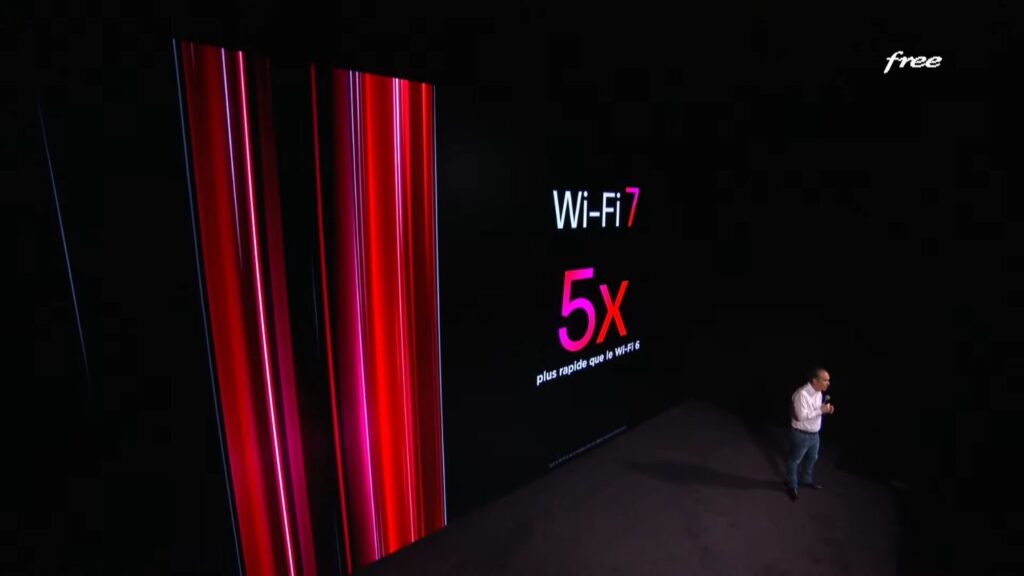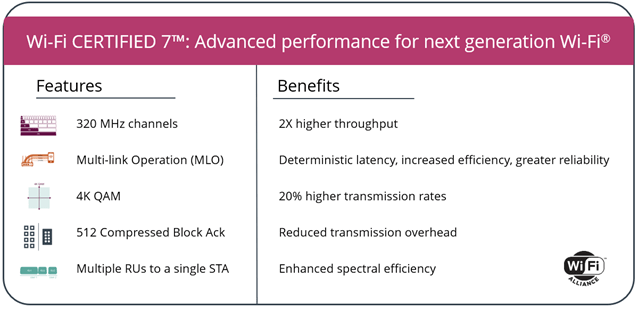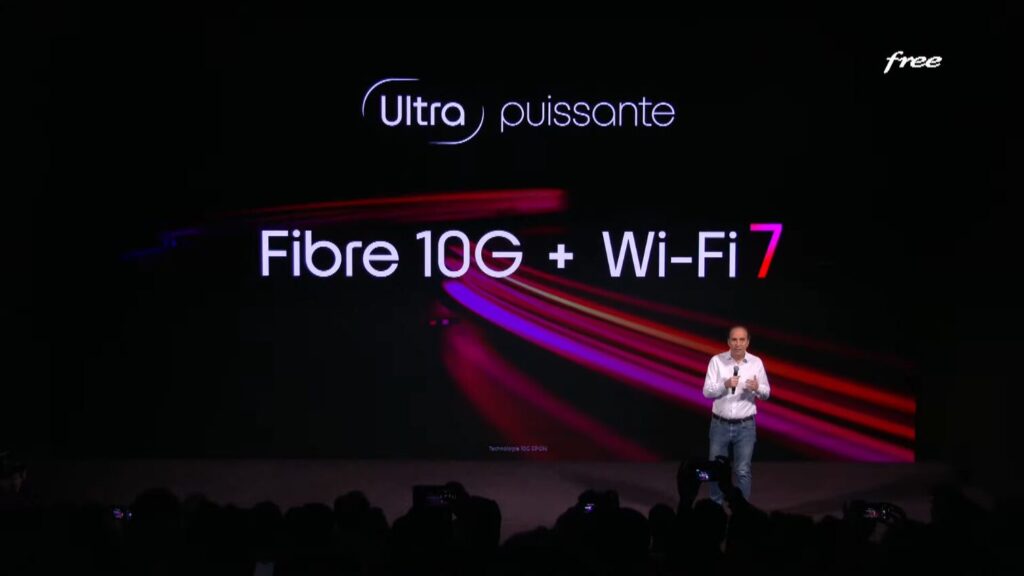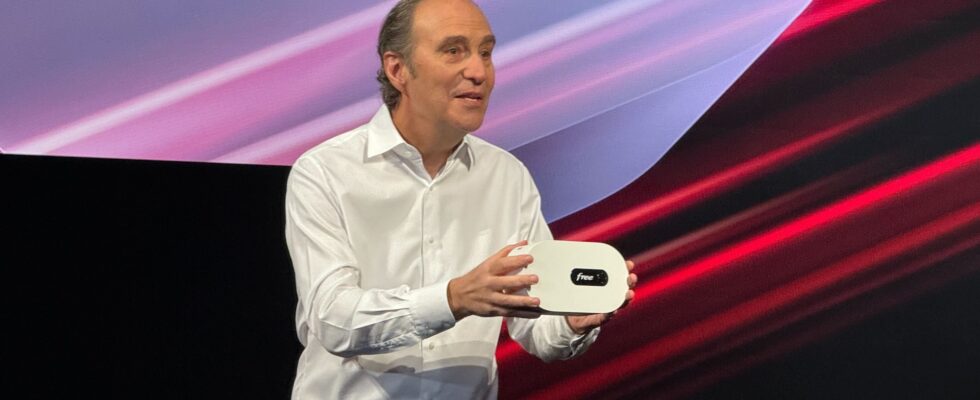Everything changes for Wi-Fi. At the beginning of 2024, a new standard — Wi-Fi 7 — was certified. This new major development in wireless communication technology will arrive very quickly in France, because Free includes it in its new box, the Freebox Ultra. In focus: more throughput and less latency.
This was one of the highlights of the presentation of the new Freebox Ultra by Xavier Niel, this Tuesday, January 30, 2024. The device, which succeeds the Freebox Delta released in 2018, welcomes a brand new wireless connectivity: the Wi-Fi. It is even the first Internet service provider in France to take the plunge.
Nothing surprising, in fact: the Freebox Ultra is above all the first box to be released in France just after the official certification of Wi-Fi 7 by the Wi-Fi Alliance. This was pronounced on January 8, after several years of gestation. A first working draft was written in March 2021, three years ago.

Opposite, the other recent boxes from SFR, Bouygues Telecom or Orange are a little older: February 2022 for the SFR Box 8X, November 2022 for the Bbox Must and October 2023 for the Livebox 7. They should not be renewed before a little moment – particularly on the side of Orange, whose Livebox 8 is not for tomorrow.
What is Wi-Fi 7?
Wi-Fi 7 is a new small revolution for the telecoms sector. Since January 8, it is officially the most advanced standard of the most famous wireless communication technology – while waiting for the next one, Wi-Fi 8, which will emerge in several years. In the meantime, it’s time for the deployment of Wi-Fi 7.
Wi-Fi 7 is the commercial and consumer name for the IEEE 802.11be standard, developed over three years. It follows in the wake of successive advances in wireless telecommunications. This path was opened in 1999 with Wi-Fi 1 until 2019, with Wi-Fi 6. It was then the most successful version.


Between, there were four intermediate generations. All these versions were formerly designated by codes unusable for the general public (such as 802.11b, 802.11n, 802.11ac, etc.). Since 2018, a new naming convention has been followed. However, the complexity has not completely disappeared, with Wi-Fi 6E or Wi-Fi 6 Release 2.
On paper, Wi-Fi 7 uses the three slices of the spectrum allocated to Wi-Fi:
- the 2.4 GHz bands (which actually extends from 2400 to 2483.5 MHz);
- 5 GHz (from 5150 to 5350 MHz, as well as from 5470 to 5725 MHz);
- 6 GHz (5945 to 6425 MHz), with support to work with existing devices.
The use of the 6 GHz band for the benefit of Wi-Fi connections was inaugurated with the Wi-Fi 6E standard.
Throughput, latency: what are the strong points for the Wi-Fi 7 standard?
The Wi-Fi Alliance, a body which brings together manufacturers of wireless systems, provides a brief description on its site. We read there that the improvements allow it “ to support a maximum throughput of at least 30 Gbps to increase performance, enable Wi-Fi innovations and expand use cases. »
Thanks to these high speeds, greater reliability and reduced latency, Wi-Fi will contribute to the emergence and democratization of other uses, according to the Wi-Fi Alliance. Virtual, augmented and mixed realities, video games, the Internet of Things for industry, automobiles, hybrid work and even immersive 3D training.
In the past, the Wi-Fi Alliance had also mentioned other scenarios: 4K and 8K streaming, the cloud, video applications and industrial uses. Anything that can benefit from a reduction in response time, a stable connection, in short. The Wi-Fi Alliance has published a technical summary of the planned advancements:


As with other Wi-Fi generations, Wi-Fi 7 is backward compatible and coexists with existing devices in the 2.4, 5 and 6 GHz frequency bands. For the general public, these developments will not always be very noticeable. What will matter most is more throughput, more stability and less latency.
When will it be released Wi-Fi 7?
In spring 2022, Qualcomm launched its first Wi-Fi 7 chip, while Wi-Fi 7 certification was not yet finalized. Two years later, Wi-Fi 7 is finalized and Free opens the way for French boxes compatible with this standard. On January 30, the operator presented its Freebox Ultra, which supports this generation.
We do not yet know when and how the three other operators (Orange, SFR and Bouygues Telecom) will take the plunge and, more generally, when other consumer equipment will manage this standard. Smartphones, consoles, tablets, computers and so on. It will take a few years.
The Wi-Fi Alliance is confident of rapid adoption: 233 million products will be compatible in 2024, and 2.1 billion in 2028. PCs, tablets, smartphones and boxes should be the first hardware to switch to it. Compatible chipmakers, such as Broadcom, Qualcomm and MediaTek, are ready.
Which box has Wi-Fi 7?
In France, the only box that has been announced compatible with Wi-Fi 7 is the new Free box: the Freebox Ultra. The operator’s other models are not compatible with this standard. For the other three operators, there is no compatibility yet with their respective boxes. We will probably have to wait for later generations.


Subscribe for free to Artificielles, our newsletter on AI, designed by AIs, verified by Numerama!
